Tagged With ‘Eau de Cologne’
Hermès
Eau de Citron Noir
2 July, 2018
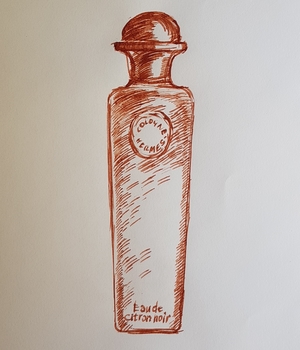 I’ve always loved eau de cologne. There’s nothing like the exhilarating zing of citrus to start your day, especially in sultry weather. The classic cologne such as 4711 Kölnisch Wasser, with its mix of citrus fruits, lavender, rosemary and neroli oil, is a well-nigh perfect (if all-too-evanescent) formulation, but over the years many perfumers have tried their hand at adding their own individual twist, with greater or lesser success.
I’ve always loved eau de cologne. There’s nothing like the exhilarating zing of citrus to start your day, especially in sultry weather. The classic cologne such as 4711 Kölnisch Wasser, with its mix of citrus fruits, lavender, rosemary and neroli oil, is a well-nigh perfect (if all-too-evanescent) formulation, but over the years many perfumers have tried their hand at adding their own individual twist, with greater or lesser success.
At Guerlain, for example, each generation of perfumers has created their own cologne, and the brand’s range of Les Eaux includes some wonderful reinterpretations such as Jacques Guerlain’s Eau de Fleurs de Cédrat from 1920, or current perfumer Thierry Wasser’s delicious Cologne de Parfumeur from 2010, which adds modern musks and a touch of cedar to the formula.
Hermès launched its first eau de cologne in 1979, with Françoise Caron’s superb Eau de Cologne d’Hermès, which was renamed Eau d’Orange Verte in 1997. For me it’s up there with Dior’s Eau Sauvage and Guerlain’s Vetiver as one of the greatest men’s perfumes around, and I’d expect that it remains their best-selling cologne. In 2009, though, Jean-Claude Ellena started expanding the range, with Eau de Gentiane Blanche and Eau de Pamplemousse Rose, followed in 2013 by Eau de Narcisse Bleue and Eau de Mandarine Ambrée.
Hermès released two more colognes in 2016, marking the handover between Jean-Claude Ellena and his successor as in-house perfumer, Christine Nagel. Ellena’s Eau de Neroli Dorée is a superb celebration of the scent of orange blossom, while Nagel’s Eau de Rhubarbe Ecarlate is fruity and great fun.
Her latest addition to the range is Eau de Citron Noir, which takes lime rather than lemon as its starting point. And not just any lime: the black lime of its name refers to the charcoal-black sun-dried limes you can buy in Oman, where they’re ground up and used as a spice. Nagel credits my fellow perfume blogger Persolaise for introducing her to this ingredient, which shows how important good blogs have become for the industry itself. Black limes give an earthy, rather sour taste to food, and lack the sweetness of fresh limes – but they also have a touch of smokiness, which Nagel has tried to recapture in her cologne.
As a fan of colognes in general and lime in particular, Citron Noir should be right up my street. And it is – at least to start with. As with most colognes, its initial, zesty burst of citrus quickly fades away, to be followed by Nagel’s recreation of the unusual fresh-but-smoky scent of black lime, which still (to me at least) has a bit of fruitiness about it. Unfortunately that’s where I get off, if I can put it that way: on my skin the fruitiness seems to turn slightly sour after a while, and that’s not what I’m looking for in a cologne. On the other hand it makes a fantastically invigorating shower gel, since its initial lime freshness has no time to disappear.
Aesop
Tacit
21 August, 2015
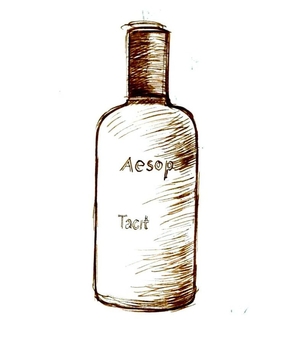 Launching worldwide in September, Tacit will only be Aesop’s second perfume (if you don’t count the long-discontinued Marrakech and Mystra), but this being Aesop there won’t be lots of razzmatazz. Everyone’s favourite Australian skincare brand likes to do things quietly, and Tacit – which means what’s left unsaid – captures the essence of Aesop pretty well.
Launching worldwide in September, Tacit will only be Aesop’s second perfume (if you don’t count the long-discontinued Marrakech and Mystra), but this being Aesop there won’t be lots of razzmatazz. Everyone’s favourite Australian skincare brand likes to do things quietly, and Tacit – which means what’s left unsaid – captures the essence of Aesop pretty well.
Created by New York-based International Flavors & Fragrances perfumer Céline Barel, Tacit is a subdued take on a classic eau de cologne, though with the grapefruit-like Japanese yuzu replacing eau de cologne’s usual lemony opening, and basil leaves taking the place of rosemary and lavender in its herbaceous heart.
The result is a fresh, unsweetened unisex scent, with a touch of the sour vermouth dryness of Haitian vetiver, extracted from the root of a tropical grass. But this is no ordinary vetiver: instead Barel has used IFF-LMR’s trademarked Vetiver Heart – a cleverly smoothed-out version of traditional vetiver oil, using hydro distillation followed by fractional distillation to extract its usual earthy smell, leaving its slightly bitter dryness intact.
Tacit comes as a 50ml Eau de Parfum (the fragrance industry’s slightly vague term for a solution containing around 10-20 per cent pure perfume) in Aesop’s standard brown glass bottles, but despite the concentration it doesn’t outstay its welcome; in fact personally I’d like it to last a bit longer. The packaging is rather more extravagant: a slim card box decorated by Australian artist Jonathan McCabe, which nestles inside a chunkier brown box, lidded with a card, which in turn slides inside a brown card sleeve.
Tacit is unlikely to turn heads on the street, but that’s not what Aesop’s about: it’s sexy but well-mannered and discreet, which pretty much sums up the brand.
Acqua di Parma
Colonia | Colonia Assoluta
14 July, 2015
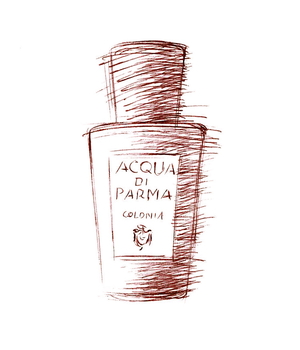 Before I start, I have to admit that the Acqua di Parma colognes have never really floated my boat, but very kindly the company have sent me some samples to try, and as it’s one of the most popular men’s fragrances I wanted to explore why that might be.
Before I start, I have to admit that the Acqua di Parma colognes have never really floated my boat, but very kindly the company have sent me some samples to try, and as it’s one of the most popular men’s fragrances I wanted to explore why that might be.
There are lots of things to like about Acqua di Parma Colonia. Its packaging, for starters, is wonderfully elegant: a golden-yellow, linen-textured cardboard tube, which splits exactly in half to reveal the bottle tightly nestled inside.
The bottle itself is a beautifully judged design, in plain glass with gently flared shoulders and a chunky black cap to match. And the typography is lovely: effortlessly stylish, with something of the 1920s about it. The whole package is an object lesson in how to make a product that says ‘classic’ and ‘quality’.
So what about the scent inside? Again, it’s classic and simple – perhaps a little too simple for me. The original Colonia was launched in 1916, and I’m presuming it was always a fresh, citrussy eau-de-cologne, though like pretty much every long-lived fragrance on the market it will almost certainly have been reformulated over the years.
That’s not always a bad thing, and today’s version may well smell more sophisticated than the original; Agua de Colonia by the Spanish brand Alvarez Gomez, for example, may conceivably have been less tinkered with, but by comparison it smells quite crude and harsh.
Not that Colonia has a particularly complex character: it’s intensely lemony when first you spray it on, but as the sharpness of the lemon fades into the background you get the clean, herbal smells of rosemary and lavender. So far so classic eau-de-cologne, but what makes Colonia different is the fact that it’s also blended with rose, which adds an unobtrusively feminine touch – a bit like the artificial jasmine scent at the centre of Eau Sauvage, though not nearly as striking in its effect.
The rose (I think) also makes Colonia smell rather talcum-powderish, which is pleasant enough but comes across as somehow rather old-ladyish – I guess because we associate powdery perfumes with an older generation. It certainly smells clean and fresh, in a soapy kind of way, and perhaps that explains its popularity among men for whom smelling clean and fresh is the main (and often only) purpose of perfume.
Personally I want to smell a bit more interesting than fresh laundry, and my other problem with Colonia is that it doesn’t last: within an hour or two I can hardly smell it on my skin. Again, that may be part of its appeal for men who are a bit nervous about wearing scent of any kind, so horses for courses, I suppose.
After its glory days in the 1920s, the Acqua di Parma company limped along until 1993, when it was bought by three rich Italian businessmen whose money came from Ferrari cars, Tod’s shoes and La Perla underwear. They launched scented candles and the like, but it wasn’t until after the luxury conglomerate LVMH took a stake in 2001 that the Colonia range was extended.
First came Colonia Assoluta in 2003, followed by Intensa in 2007, Essenza in 2010 and Intensa Oud in 2012. I have all of these versions apart from Intensa Oud, and I have to admit that, though I thought I had a fairly sensitive sense of smell, the differences between them are so subtle that I find them almost impossible to tell apart.
Colonia Assoluta was formulated by two of the best-known perfumers around today: Jean-Claude Ellena (creator of Vétiver Tonka, among others) and Bertrand Duchaufour (creator of many unusual fragrances, especially for L’Artisan Parfumeur), which is a bit like getting Debussy and Ravel to compose a duet. The results should be extraordinary, but these two great talents seem to have cancelled each other out: Colonia Assoluta is discreet to the point of invisibility, like a plain grey Hermès jumper.
What Duchaufour and Ellena seem to have done is shuffled a few of the ingredients of the original Colonia about a bit – changing the lavender for jasmine, for example – but it’s all so carefully balanced that the overall effect is almost identical, though you can smell a faint difference after an hour or two. Their work is certainly very subtle and clever, like Gus Van Sant’s frame-by-frame remake of Psycho, but you could argue that it’s equally pointless.
The same conjuring trick, if it’s fair to call it a trick, seems to have been achieved with the Essenza and Intensa versions: in each of them the ingredients are slightly different, but their smell is even less varied than their packaging (Essenza comes in a black tube, but is otherwise, ahem, a carbon copy).
Brilliant or bonkers? Delicious discreet or disappointingly dull? I’ll have to let you compare them for yourself. Maybe my nose isn’t as super-sensitive as it should be, but I’d be interested to hear what other people think. All the same, thank you to Acqua di Parma for letting me give them a try: they certainly look very handsome on my perfume shelf.
Annick Goutal
Eau de Monsieur
26 March, 2015
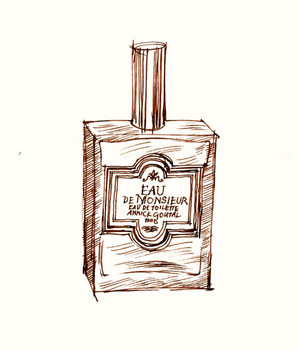 Mention the name Annick Goutal and the first scent that springs to mind is Eau d’Hadrien, the intensely lemony, slightly hair-sprayish scent that was launched in 1981 and went on to become the company’s best-seller.
Mention the name Annick Goutal and the first scent that springs to mind is Eau d’Hadrien, the intensely lemony, slightly hair-sprayish scent that was launched in 1981 and went on to become the company’s best-seller.
But before Eau d’Hadrien came Eau de Monsieur. Launched in 1980, discontinued for a while and then relaunched in 2013, it shares its lemony, eau de cologne-like zest with Eau d’Hadrien, but it’s an altogether quieter, softer fragrance.
Eau de Monsieur, like Eau d’Hadrien, is based around the zesty, zingy smell of lemons and the slightly pear-drop-lemony sweetness of lemon verbena (extracted from the leaves of a straggly South American shrub).
But while that’s pretty much the start and the finish of Eau d’Hadrien, that initial burst of sharp sweet freshness quickly fades to reveal what smells a bit like a sun-drenched Greek mountainside underneath – that scent of crushed thyme, cistus leaves and lavender, which in this case has an added touch of helichrysum, that strong-smelling everlasting flower that the French call immortelle.
Immortelle isn’t a scent that everybody loves: to me it has the richness of brandy and Christmas pudding and crackling pine-log fires, but to other people it has a medicinal TCP smell, which isn’t something you necessarily want in a perfume.
In Goutal’s fantastic Sables, released a few years later in 1985, immortelle is the main ingredient, but in Eau de Monsieur it’s used in moderation to give a subtle background sweetness. According to the list of ingredients on the Annick Goutal website, it also includes patchouli and sandalwood, which add a bit of their gentle warm woodiness to the mix, and there’s a little bit of bitterness too, which other writers have ascribed to that classic men’s-fragrance ingredient, vetiver.
It’s not, perhaps, the most original perfume out there, and it’s disappointing to discover that it only last an hour or so on the skin, but Eau de Monsieur is classy, attractive, natural-smelling and easy to wear, which is a lot more than you can say for the majority of men’s fragrances.
Frederic Malle
Cologne Bigarade
10 January, 2015
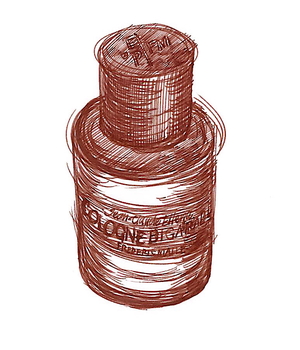 Every morning for my breakfast I have tea, toast and home-made marmalade. It’s one of my favourite things, and I love the bittersweet smell of Seville oranges, which only appear in the shops for a couple of weeks around this time of the year.
Every morning for my breakfast I have tea, toast and home-made marmalade. It’s one of my favourite things, and I love the bittersweet smell of Seville oranges, which only appear in the shops for a couple of weeks around this time of the year.
In fact as I sit here writing this post in January, Roy is busy cooking marmalade next door, and the powerful odour of bitter orange (known as bigarade in French) is suffusing the house from kitchen to attic.
So it could hardly be a better time to review Cologne Bigarade, created by the perfumer Jean-Claude Ellena for the French fragrance curator and marketeer, Frédéric Malle (nephew of the film director Louis Malle). Launched in 2001, it was one of the first of the Editions de Parfums Frédéric Malle, and to my mind it’s one of the most immediately appealing and easy to enjoy.
On first – I was going to say ‘glance’, but I suppose I should say ‘spritz’, it smells like a simple but high-quality natural scent, with the exact mix of sweet green freshness and slight bitterness that you get from orange peel and its bitter pith.
You could, I guess, just bottle Seville-orange extract and have done with it – and apparently Jean-Claude Ellena did commission a special new essence for this scent, obtained by molecular extraction. But like all good perfumes Bigarade Cologne is ultimately a clever recreation of what seems, on the surface, like a simple natural scent, using a careful balance of other ingredients to enhance and support the main ingredient.
In this case, Ellena has added a bit of hay and grass – or rather their synthesised essences – which makes the orange even fresher somehow, then subtly underpinned it with a little cedar-wood and rose, adding extra depth and staying-power. You could even say that these extra ingredients suggest the smell of the leaves and the twigs of orange trees, though perhaps that’s going too far.
(Actually, unless you concentrate very hard you can’t really smell them at all; but then we’re so suggestible when it comes to scents that once someone has told you that a particular ingredient is present, you’re more than likely to ‘smell’ it whether it’s actually there or not.)
To me Cologne Bigarade also has a very slight and not unpleasant sweatiness, which (from a short trip to the kitchen and back) is part of the authentic Seville orange smell. In perfume that faint sweatiness is often derived from cumin, and I wonder if there might be a touch of that classic curry spice here too.
Cologne Bigarade is not, perhaps, the most complex perfume on the market, but like most of Jean-Claude Ellena’s fragrances it’s rather more thoughtful and unusual than the general run. Given that he’s also the in-house perfumer for Hermès, it immediately made me think of Hermès’ classic Eau d’Orange Verte, which is also based on the scent of bitter oranges. Though that perfume was originally created by Françoise Caron in 1979, Ellena developed a new version in 2004 called Concentrée d’Orange Verte.
Eau d’Orange Verte is one of my all-time favourite fragrances, yet comparing them side by side, it smells sharper and fresher, but perhaps also slightly less interesting than Cologne Bigarade, which also seems to have much more staying power (a rare quality in a citrus-based cologne, though you can also find it in the fantastic sherbet-lemon Monsieur Balmain).
All the fragrances in the Editions de Parfums Frédéric Malle are expensive, and Cologne Bigarade is no exception, even if its packaging is extremely smart. The heavy, plain-glass bottle has a chunky black cap and comes in a slide-out, black foam-padded box, which in turn slides out (with some effort) of a scarlet card wrapper. If you have money to burn then there’s an even more expensive version called Bigarade Concentrée, which I’ve smelled as a sample and lasts even longer than Cologne Bigarade. The concentrated version also seems to have less of that faint sweatiness about it, which I suspect many people would prefer; I think I do too.
Either way, a fresh but unusual cologne is a wonderful thing to have, so full marks to Jean-Claude Ellena and Frédéric Malle for giving men something a bit different to wear. In a similar vein, though with a very different smell, is Malle’s Geranium Pour Monsieur, which I hope to be able to review before long; watch this space.
Guerlain
Cologne du Parfumeur
6 August, 2014
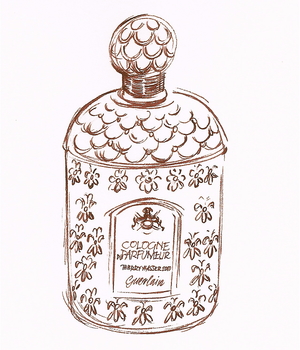 If there’s one scent that appeals to pretty much everyone then surely it’s eau-de-cologne, the zesty, refreshing blend of lemon and herbs whose (probably medicinal) origins are lost in the mists of time. Its oldest surviving surviving incarnation is the German No. 4711 Echt Kölnisch Wasser from – where else – Cologne, which you can buy for not very much from pretty much anywhere, but there are hundreds of other versions, from the cheap and nasty all the way up to Chanel’s divine (and divinely expensive) Eau de Cologne.
If there’s one scent that appeals to pretty much everyone then surely it’s eau-de-cologne, the zesty, refreshing blend of lemon and herbs whose (probably medicinal) origins are lost in the mists of time. Its oldest surviving surviving incarnation is the German No. 4711 Echt Kölnisch Wasser from – where else – Cologne, which you can buy for not very much from pretty much anywhere, but there are hundreds of other versions, from the cheap and nasty all the way up to Chanel’s divine (and divinely expensive) Eau de Cologne.
The basic ingredients of eau-de-cologne are extracts of citrus fruits, which give it its instant freshness, blended with a variety of herbs, usually including lavender and rosemary, which add extra staying-power and warmth. It’s more of a style than a formula, and every different eau-de-cologne has a slightly different combination of ingredients, though they all share a broadly similar character. They all suffer from one drawback, too, which is that they quickly fade away on the skin.
As one of the most historic perfume companies, Guerlain has produced a number of different takes on eau-de-cologne over the years, starting with Eau de Cologne Impériale in 1853, followed by Eau de Cologne du Coq in 1894, the glorious Eau de Fleurs de Cédrat in 1920, and Eau de Guerlain in 1974.
Cologne du Parfumeur was launched in 2010, and is the first not to have been dreamed up by a member of the Guerlain family. Its creator, the Swiss perfumer Thierry Wasser, became the company’s in-house perfumer in 2008, after the retirement of Jean-Paul Guerlain. Wasser’s interpretation of the classic eau-de-cologne retains plenty of citrusy zing, but with more orange than lemon in the mix, which makes it smell slightly sweeter and less astringent than the general run of colognes. The blend of orange used here is particularly ‘green’, which makes a bit more sense if you think of orange flowers surrounded by their glossy dark-green leaves.
Wasser accentuates this ‘greenness’ with tiny amounts of fresh-smelling mint, as well as plenty of lavender and rosemary, those classic eau-de-cologne herbs. I think I also smell a little bit of bracing juniper, which gives Voyage d’Hermès its gin-and-tonic swing. Overall it’s a gentle, appealing scent, and Wasser has given it extra staying-power thanks, it seems, to the inclusion of long-lasting synthetic musks, which add their own soft, slightly sensual touch.
Cologne du Parfumeur comes in Guerlain’s classic ‘bee’ bottle, with fish-scale patterned shoulders, 69 stylised embossed bees on the sides and a rather cheap-feeling plastic top, though customised, hand-gilded versions are available for a suitable fee. What’s most interesting is its label, which includes ‘Thierry Wasser 2010’ – a new departure for Guerlain, and one of the earlier signs that perfumers had started becoming celebrities in their own right.
More recent releases…
25 July, 2014
So many new men’s fragrances come out every year that it would be a full-time job to review them all – and probably not a very rewarding one. But while I’m keen to celebrate my favourites on The Sniff Box, it seems only polite to give brief reviews to some of the recent releases that I’ve kindly been given by perfume companies, even if they don’t (in my view) merit a longer review.
I took the first of these, DKNY MEN ENERGIZING EAU DE COLOGNE SPRAY, into an office where I was working and asked my male colleagues to tell me what they thought of it. After some consideration and a surprising amount of sniffing, they came back with, ‘It’s the kind of bottle you’d expect to see in a teenage boy’s bedroom, but actually it’s not as bad as we expected.’
Personally I think it’s almost indistinguishably generic and very synthetic-smelling, with none of the refreshing citrus of a classic eau-de-cologne, though it is faintly cucumberish or melony. The bottle, incidentally, is an unfeasibly tall rhomboid with a naff transfer of the Empire State Building up one side, a clear plastic cap and a spray button in electric blue. Teenage boy’s bedroom, in other words.
RENSHAW, from Murdock, is the latest cologne from a small British brand which has grown out of a chain of trendy barber shops owned by Irish-born Brendan Murdock. Renshaw was launched during Wimbledon week and, appropriately for a perfume with a tennis theme, smells like grass with a splash of sharp sweetness – though in this case it’s grapefruit, not strawberries. It’s perfectly pleasant, and probably perfect for its intended audience: describing itself as ‘British Cologne’, it’s a little bit Boy’s Own – not too fancy, complex or expensive.
The name JIMMY CHOO MAN gives me the uncomfortable image of a bloke in high heels, which I hope is unintentional. This first (but almost certainly not last) men’s perfume from the high-fashion shoe brand comes in a curved grey-glass bottle with rather 1970s-looking silver lettering, topped off with a matching metal plate and a metal-topped cap wrapped in faux snakeskin.
As for the fragrance itself, it smells at least as chemical as the DKNY Men Energising Eau de Cologne. Generic, in a word, and quite hard to distinguish from, say, Paul Smith Extreme Sport or a hundred other men’s fragrances from the last decade. Though it’s not being released until September, I won’t be holding my breath, though I might be holding my nose.
Hermès
Concentré d’Orange Verte
18 July, 2014
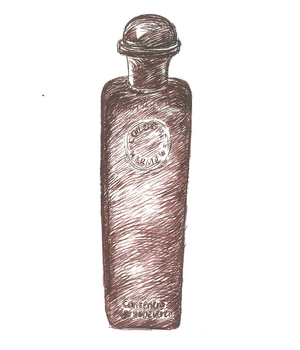 In 1979, Hermès launched a brilliant take on the classic men’s eau-de-cologne. Simply called Eau de Cologne d’Hermès, it was created by Françoise Caron, who you could almost say had perfume in her blood. Born in the one-time capital of French fragrance, the Provençal town of Grasse, into a family that worked in the perfume trade, both she and her brother, Olivier Cresp, became highly regarded professional perfumers in their own right.
In 1979, Hermès launched a brilliant take on the classic men’s eau-de-cologne. Simply called Eau de Cologne d’Hermès, it was created by Françoise Caron, who you could almost say had perfume in her blood. Born in the one-time capital of French fragrance, the Provençal town of Grasse, into a family that worked in the perfume trade, both she and her brother, Olivier Cresp, became highly regarded professional perfumers in their own right.
Many perfumes are variations on a theme, and the fresh, citrusy scent of eau-de-cologne is probably the best-known theme of all. But some variations are more interesting and successful than others, and Françoise Caron’s master-stroke was to turn up the volume, if you like, on a single ingredient – bitter orange – that plays a subsidiary role in most colognes.
The effect is delicious and bracingly sour-sweet, like a proper old-fashioned lemonade, but because orange is a more powerful, complex citrus scent than lemon it has far more depth and staying power. Françoise Caron also included mint (which adds a minor cooling touch), as well as lime and blackcurrant buds – which, if like me you have blackcurrant bushes in your garden, you’ll know have an intriguing scent, both sweet and slightly foxy.
Eau de Cologne d’Hermès continued in production until 1997, when Hermès changed its name to the slightly more individual Eau d’Orange Verte, though the scent remained the same. One criticism of Caron’s original perfume was that it didn’t last very long, and presumably as a response to this, in 2004 a concentrated version was released, tweaked by in-house perfumer Jean-Claude Ellena and helpfully called Concentré d’Orange Verte.
It’s this version I like best, I suppose because it seems to have retained all the character of Françoise Caron’s original yet packs a rather more powerful punch, and on my skin at least it certainly seems to last a good hour or two. It’s a zesty, uplifting and – I’d say – a happy scent, and one that I’d happily wear every day. Perfect for lifting the spirits on a dull grey Monday morning.
Hermès
Eau de Mandarine Ambrée
1 June, 2014
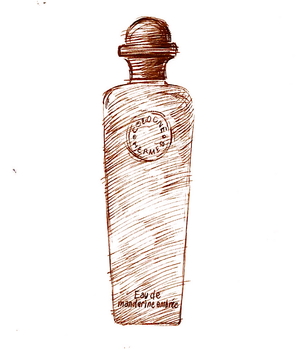 Now this is fun. Eau de Mandarine Ambrée isn’t perhaps the most sophisticated perfume in the world, but it’s a jolly, cheering little scent, that smells sweet and zesty and pretty much exactly like mandarin juice when you first spray it on. It was launched in 2013, at the same time as Eau de Narcisse Bleu, and brings the number of Hermès colognes up to five (the other three being Eau d’Orange Verte, Eau de Gentiane Blanche and Eau de Pamplemousse Rose).
Now this is fun. Eau de Mandarine Ambrée isn’t perhaps the most sophisticated perfume in the world, but it’s a jolly, cheering little scent, that smells sweet and zesty and pretty much exactly like mandarin juice when you first spray it on. It was launched in 2013, at the same time as Eau de Narcisse Bleu, and brings the number of Hermès colognes up to five (the other three being Eau d’Orange Verte, Eau de Gentiane Blanche and Eau de Pamplemousse Rose).
Like all the more recent Hermès perfumes it was created by Jean-Claude Ellena, whose celebrity status says much about how the industry has changed over the last decade or so – in the past no one would have known his name. His perfumes are nearly always interesting, if not always terrifically commercial, and Hermès seem to have given him licence (if you’ll forgive the pun) to follow his own nose and see where it takes him, especially with the colognes and it Hermessences range – see my review of Vétiver Tonka.
Ellena is very interested in food, and like quite a few of his perfumes, Eau de Mandarine Ambrée reminds me of cooking smells: nice cooking smells, that is. In this case it reminds me of the ugli-fruit marmalade that Roy made this year, which is very nice in its own way, but lacks the tartness of Seville-orange marmalade, and tastes a bit too sweet and jammy as a result.
Still, you could do far worse than start your day with Eau de Mandarine Ambrée. It’s light and refreshing and puts a smile on your face, yet it’s longer-lasting than most citrus-based colognes. This seems to be because Ellena has combined mandarin with a bit of passion-fruit extract and what’s known in the perfume trade as amber (thus Mandarine Ambrée).
‘Amber’ is one of those confusing terms that gives perfumery a bad name: it’s nothing to do with amber, the fossilised resin, or ambergris, the strange waxy lumps that whales occasionally cough up after swallowing too many cuttlefish (I kid you not), which develop a wonderful aroma only after bobbing around in the sea for a few years.
For perfumers, ‘amber’ refers to a careful blend of several ingredients, usually vanilla, benzoin and labdanum, which together give a sweet, slightly resinous and powdery smell. Ellena himself says that ‘I can think of no smell more joyful than mandarin, more mellow than amber,’ and I guess it’s the amber that helps Eau de Mandarine Ambrée last as long as it does.
Would I wear it a lot? Personally I prefer the sharper smells of colognes like Monsieur Balmain and Eau d’Orange Verte, but for anyone who likes something a bit sweeter and softer then Eau de Mandarine Ambrée would be a very happy choice.
The job-interview fragrance
20 July, 2012
I was walking down Shaftesbury Avenue last week when I noticed, just ahead of me, a young woman standing outside the lobby of some fairly swanky offices. As I got closer, she reached into her handbag and produced one of those slimline canisters of scent, which she proceeded to spray all over herself like a crop duster until a cloud of foul-smelling perfume drifted across the entire street.
It was only at this point that it struck me how dressed- and made-up she was, and the thought crossed my mind that she must be going for an interview – in which case pity the poor interviewers. I spent the rest of the morning wondering what effect reeking of bad perfume might have on one’s chances.
If there’s a moral to the story (other than move fast if you ever see anyone getting a scent spray out of their bag), perhaps it’s that perfume, if it doesn’t exactly maketh the man, certainly maketh a bigger impression than one might imagine. I can’t imagine many blokes carry their favourite fragrance around with them, but choosing the right perfume for an important occasion is just as crucial for a man as for a woman. Get it wrong and you could ruin your chances.
Discretion may be the better part of valour, but it’s also a good guide when choosing a perfume for a job interview. The easy way out would be not to wear perfume at all, but wearing a really good but understated classic fragrance does wonders for one’s self-confidence – and can also make a good impression on other people, often without them even knowing why.
As far as fragrances go, it’s hard to beat something that embodies old-fashioned masculinity, such as Guerlain’s Vetiver. For something a bit warmer I’d choose Chanel’s Pour Monsieur, not least because it’s actually quite hard to overdo it. It’s a lovely discreet perfume, but if you’re feeling flush then the same company’s delicious, slightly lavendery Eau de Cologne is even finer – though as someone said to me the other day, ‘It’s a lovely cologne, but if I was going to spend that much money I’d buy something a bit more unusual.’
Fair enough – but surely it’s better to invest in a great fragrance than saving your money and smelling like fabric conditioner? Just remember that poor deluded girl on Shaftesbury Avenue. I wonder if she got the job?